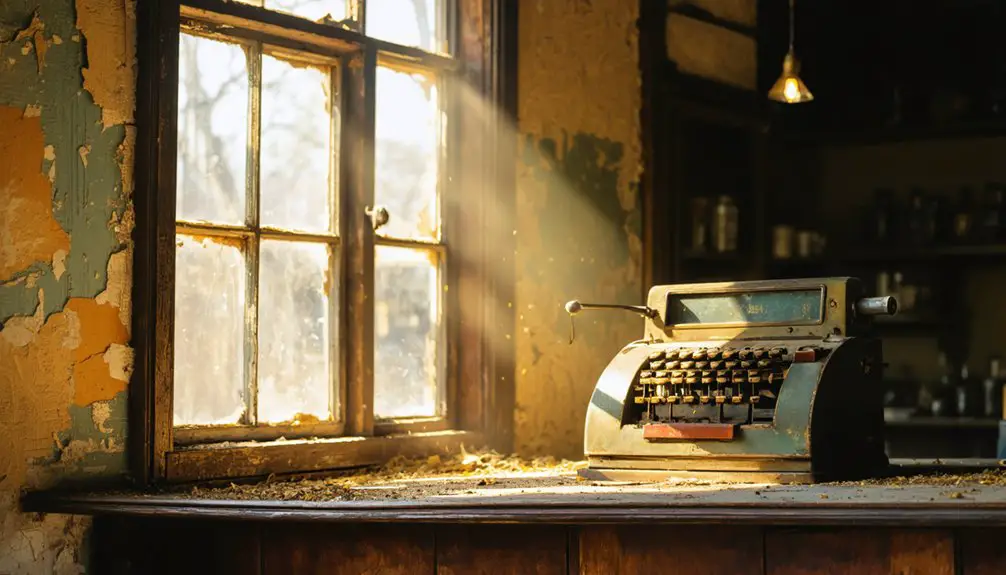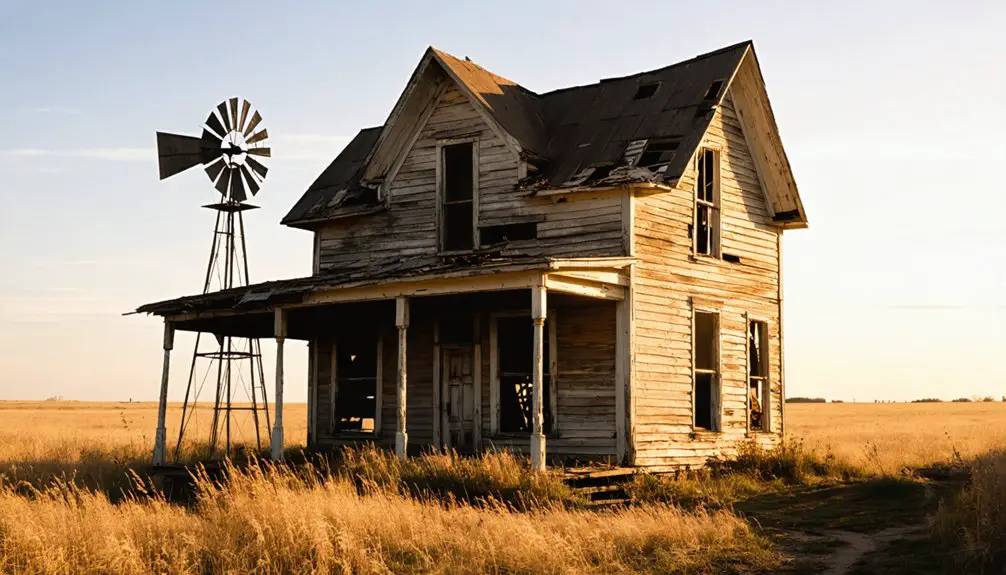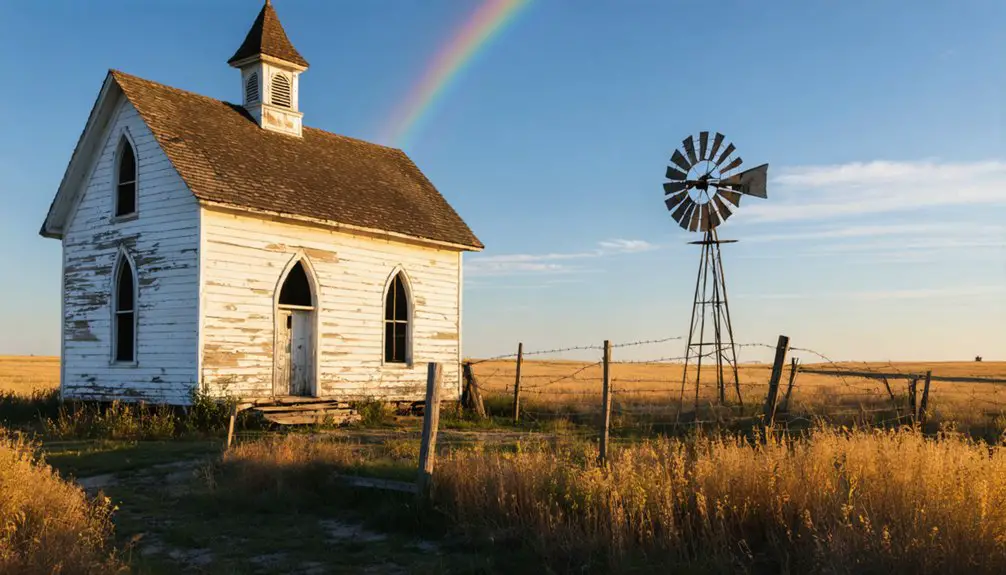You’ll find Taloga nestled in the heart of Kansas, a ghost town that emerged during the Great Land Run of 1892. The settlement once thrived as a bustling frontier community, complete with a courthouse square, business district, and a central well at Main and Broadway. Its Native American name, meaning “beautiful valley,” reflects the region’s indigenous heritage. Today, Taloga’s weathered structures stand as silent sentinels, each holding untold stories of frontier life.
Key Takeaways
- Taloga is an abandoned settlement in Kansas that represents the historical legacy of early American frontier settlements.
- The town’s name has Native American origins, meaning “beautiful valley” or “rocking water” in the Creek language.
- Taloga was officially established during the 1892 Land Run, when settlers rushed to claim former Cheyenne-Arapaho reservation lands.
- The town flourished as a commercial center through the 1920s with modern amenities, serving the local farming and ranching community.
- Economic changes, railroad abandonment, and urban migration led to Taloga’s eventual decline and current ghost town status.
Origins and Native American Heritage

Nestled in a horseshoe bend of the South Canadian River, Taloga’s name reflects the rich Native American heritage of the region, likely deriving from indigenous languages with possible meanings of “beautiful valley” or “rocking water” in Creek.
The town’s establishment on former Cheyenne and Arapaho reservation land highlights its deep cultural significance in Native American history.
You’ll find that this area was once part of the “Leased District,” where various Plains Indian tribes migrated through what’s now western Oklahoma.
The town was officially established during the historic land run of April 19, 1892.
Similar to the Kansa language’s influence on Kansas’s name, Taloga’s indigenous nomenclature demonstrates the lasting impact of Native American languages on geographical names.
The region saw the passage of Choctaw and Seminole peoples following their removal in the 1830s.
Like many places in Kansas, Taloga’s name serves as a lasting reminder of the indigenous peoples who first called this land home, preserving their legacy in the landscape’s nomenclature.
The Great Land Run of 1892
You’ll find that Taloga’s story intertwined with the Great Land Run of 1892, when settlers rushed to stake their claims in the newly opened Cheyenne-Arapaho lands.
Law enforcement struggled to maintain order as “sooners” illegally entered the territory before the official noon start, leading to numerous disputed claims and occasional violence. Starting guns and military pistols fired signaled the beginning of the dramatic rush into the territory.
Within days of the run, you would’ve seen the beginnings of organized settlement as new residents marked their lots and began planning the infrastructure that would support their burgeoning community. The settlers, coming from Kansas, Texas, and Missouri, brought diverse backgrounds and experiences to their new homesteads.
Rush for Prime Lots
When the Cheyenne-Arapaho Reservation lands opened on April 19, 1892, more than 25,000 enthusiastic settlers rushed to claim their piece of the 3.5 million acres available in western Oklahoma.
The rush attracted a diverse crowd including Kansans and Texans seeking new opportunities.
You’d have seen determined settlers employing various land claim strategies – some on horseback, others running on foot – all racing to stake the choicest parcels near water sources and railroads.
The competitive pressures were intense. Mounted riders struggled to control frightened horses while others marched forward singing hymns. Most settlers found the territory to be barren grassland suitable only for grazing cattle.
Even after a young girl broke her leg in the chaos, her claim spot remained secure.
Despite the frenzied rush for prime locations, nearly four-fifths of the land remained unclaimed, suggesting either an overestimation of demand or terrain unsuitable for farming.
Law and Order Challenges
Despite the military’s efforts to maintain order during the Great Land Run of 1892, widespread lawlessness plagued the newly opened territories.
You’d have witnessed soldiers and deputies struggling to control the chaos as settlers raced to claim prime plots.
Law enforcement faced significant challenges:
- Rampant “sooner” activity with settlers illegally entering lands early
- Violent confrontations between claim jumpers and legitimate settlers
- Accusations of bribery and misconduct among military personnel
- Difficult-to-prove claim disputes flooding federal courts
- Conflicts between indigenous rights and illegal cattle grazing
The Cherokee Nation’s calls for protection went largely unanswered as troops found themselves overwhelmed.
Even with additional cavalry and infantry deployed across four military districts, they couldn’t prevent the disorder that would shape these frontier territories for years to come.
The limited hours at nine registration booths created massive crowds and dangerous conditions for settlers seeking claim certificates.
The intense heat led to multiple cases of heat prostration among those waiting in the registration lines.
Settlement Planning Begins
As federal surveyors prepared for the monumental Land Run of 1892, they meticulously carved out 4.3 million acres of former Cheyenne and Arapaho territory into six distinct counties.
You’d have witnessed their settlement strategies unfold as they designated county seats like Watonga, Arapaho, and Taloga, while setting aside precious land for schools, courthouses, and public institutions.
The community organization extended beyond mere boundaries.
You’d have seen soldiers patrolling the borders to maintain order, though some “sooners” managed to slip through.
The government’s careful timing of the noon start reflected their determination to manage the massive influx of settlers.
Despite these precautions, you’d have noticed the challenges of enforcing regulations across such vast territory, where some settlers found ways to stake early claims through bribery or stealth.
An estimated 25,000 participants rushed to claim their piece of the newly opened territory.
President Benjamin Harrison’s proclamation set the official guidelines for the settlement process.
Early Town Planning and Development
While the Oklahoma Territory was still opening up to settlement, Taloga emerged from a carefully planned 320-acre townsite surveyed in 1892. The town layout reflected strategic civic planning, with dedicated spaces for a courthouse square, business district, and residential areas.
- A public well at Main and Broadway became the heart of community life.
- Frame buildings housed the first county offices at this significant intersection.
- The business district thrived with livery stables, medical services, and merchants.
- Churches found their home on specially reserved lots.
- The South Canadian River’s horseshoe bend provided natural protection.
You’ll find evidence of the founders’ vision in every corner of the original plat, from the thoughtfully positioned commercial lots to the early installation of electric lighting and utilities – all marking Taloga as a frontier town destined for prominence.
Life in the Bustling Frontier Community

Three distinct social groups shaped daily life in frontier Taloga: settlers seeking opportunity, Native Americans maneuvering territorial changes, and a mix of lawmen and outlaws establishing order and chaos.
You’d have found a bustling frontier economy centered around the town’s core, where merchants, doctors, and dentists offered their services.
The public well at Main and Broadway served as a hub for social interactions, where you’d gather not just water but the latest news and gossip.
The post office and courthouse brought stability to daily life, while general stores supplied essential goods to ambitious settlers.
You’d need to stay vigilant, though – the community organized watches against potential threats, and former outlaws sometimes filed land claims under false names, adding an edge of danger to this frontier settlement’s promising opportunities.
Key Historical Structures and Landmarks
As you walk through Taloga’s remnants today, you’ll find the weathered foundation stones of what was once an impressive courthouse and jail complex that anchored the town’s civic life.
The Main Street business district, though largely gone now, reveals its footprint through scattered brick fragments and the occasional storefront foundation marking where merchants once conducted trade.
At the heart of the settlement, you can still locate the old public water well plaza where townsfolk gathered daily, its stone coping still visible as a demonstration of the community’s shared resources.
Courthouse and Jail Complex
Following its establishment as the Dewey County seat, Taloga developed a significant courthouse and jail complex that became the cornerstone of local governance.
The evolution of jail architecture spans from the first 1842 stone structure to the 1922 concrete facility, while courthouse functions expanded through multiple buildings to serve growing administrative needs.
- The original 1842 jail featured a blend of stone, wood, and iron construction on the public square’s east end.
- A more secure jail rose in 1867, boasting two-foot-thick stone walls and eight cells across two stories.
- The 1901 courthouse marked Taloga’s growing prominence as a county seat.
- By 1925, a modern courthouse earned future National Register recognition.
- The 1922 concrete jail served until 1981, now preserved as the Dewey County Jailhouse Museum.
Main Street Business District
While historical records indicate that Taloga is actually located in Oklahoma rather than Kansas, the state of Kansas itself harbors numerous ghost towns with notable Main Street districts that tell compelling stories of frontier commerce.
You’ll find remnants of business diversity in these forgotten thoroughfares, from weathered general stores and blacksmith shops to historic saloons that once buzzed with community engagement.
The streets were lined with log buildings and post offices that served as essential communication hubs.
These Main Streets weren’t just business centers – they were the heart of frontier life, hosting community gatherings and local events.
Though many structures now stand empty, their architectural details hint at the vibrant commercial and social activities that once defined these spaces.
Public Water Well Plaza
The Public Water Well Plaza stands as a tribute to Taloga’s pioneering spirit, situated at the intersection of Main and Broadway streets in Oklahoma. As the town’s first reliable water source, this well transformed a barren intersection into a vibrant community gathering spot that shaped Taloga’s early development.
- Served as the lifeline for settlers, livestock, and businesses needing fresh water
- Became the social heart of Taloga’s civic district
- Supported significant county services and infrastructure
- Tapped into the crucial Ogallala Aquifer system
- Remains a symbol of the town’s resilient heritage
You’ll find this historic landmark still anchoring the original town layout, reminding visitors of the essential role groundwater played in sustaining life in this semi-arid region.
The plaza represents the determination of early settlers who built their future around this indispensable resource.
Economic Rise and Transformation
As Taloga secured its position as Dewey County’s seat in the early 1900s, federal surveyors laid out an ambitious 320-acre townsite that would shape the community’s economic foundation.
Federal surveyors mapped Taloga’s destiny with a bold 320-acre plan, establishing the county seat’s future economic path.
You’d have found a bustling center of commerce, complete with a courthouse, jail, and modern electric plant lighting the streets by the 1920s.
The town’s economic sustainability stemmed from its prime location in the South Canadian River’s horseshoe bend, where agricultural development thrived in the fertile valley.
While Taloga didn’t secure a railroad connection like some of its Kansas counterparts, State Highway 183 kept the town viable.
Local businesses – from mercantile stores to medical practices – served the farming and ranching community, while the county government presence helped maintain Taloga’s regional importance through economic fluctuations.
The Path to Abandonment

Despite Taloga’s promising start, shifts in agricultural practices and transportation patterns during the 1930s marked the beginning of its decline.
You’ll find that economic shifts hit the town particularly hard as mechanized farming reduced the need for agricultural workers.
- Railroad lines were abandoned, cutting off crucial transportation links
- Young residents moved to urban areas seeking better opportunities
- Essential services and utilities gradually disappeared
- Local businesses couldn’t sustain themselves with the population decline
- Community institutions like schools and churches closed their doors
The town’s fate was sealed by a perfect storm of challenges that you might recognize from other ghost towns across Kansas.
As government investment dwindled and infrastructure crumbled, remaining residents faced difficult choices.
The transformation from a bustling agricultural hub to an abandoned settlement reflects the broader story of rural America’s changing landscape.
Legacy of a Lost Settlement
Modern visitors to Taloga’s remnants will find more than just abandoned buildings – they’ll discover a rich tapestry of frontier history woven into Oklahoma’s territorial expansion.
The town’s cultural significance extends beyond its physical remains, from the 1920s courthouse to the historic water well at Main and Broadway that once served both residents and livestock.
You can trace Taloga’s community identity through its progressive infrastructure, including early electric lighting and planned urban design.
The town’s Native American name, meaning either “beautiful valley” or “rocking water,” connects you to the region’s indigenous heritage.
While the buildings may be silent now, they tell powerful stories of frontier development, from the occasional outlaw to the determined settlers who built churches, schools, and businesses in pursuit of their dreams.
Preserving Taloga’s History Today

While Taloga’s physical structures may be fading, dedicated preservation efforts secure its legacy endures through multiple channels. Through digital archives and community storytelling, you’ll find a rich tapestry of history being maintained by passionate locals and historians.
- Local historical societies actively collect and digitize photographs, documents, and oral histories.
- Remaining physical landmarks receive careful cataloging and stabilization to protect against deterioration.
- Annual reunions and picnics keep community connections alive and preserve shared memories.
- School programs integrate Taloga’s story into regional heritage education.
- Online platforms host virtual tours, interactive maps, and crowdsourced collections.
You can explore Taloga’s heritage through various preservation initiatives, from traditional archival efforts to modern digital platforms.
Physical site maintenance, combined with documentation and educational programs, secures this Kansas ghost town’s story continues to captivate future generations.
Frequently Asked Questions
What Role Did the Dalton Gang Play in Taloga’s Underground Criminal Activities?
Like shadows in moonlight, you’ll find the Dalton Gang’s criminal activities near Taloga weren’t directly documented, but their widespread criminal influence shaped the region’s underground networks through robberies and violent raids.
How Did Natural Disasters Specifically Affect Taloga’s Population Over the Years?
You’ll find that flood damage repeatedly destroyed homes and infrastructure, while drought effects devastated local agriculture. These natural disasters forced many residents to abandon their properties, steadily diminishing Taloga’s population.
Were There Any Notable Conflicts Between Settlers and Native Americans?
You’ll find that settler conflicts near Taloga were part of broader regional tensions, with Pawnee-Kansa rivalries and raids extending into the area, though specific native relations weren’t well documented for Taloga itself.
What Happened to the Original Documents and Records From Taloga’s Courthouse?
Like many frontier town records, you’ll find Taloga’s courthouse documents were transferred to Hays when it became county seat, though some lost archives through courthouse fires remain unaccounted for in Ellis County.
Did Any Famous Historical Figures Ever Visit or Live in Taloga?
You won’t find records of any famous visitors living in or passing through, except for early Dalton gang outlaws who allegedly filed land claims using fake names during initial settlement.
References
- https://www.okhistory.org/publications/enc/entry?entry=TA009
- https://www.hhhistory.com/2019/05/ghost-towns-of-kansas.html
- https://www.youtube.com/watch?v=VPZtNoncnig
- https://www.youtube.com/watch?v=Td_gmiDMfI4
- https://www.youtube.com/watch?v=alC1wDdSVvg
- https://www.youtube.com/watch?v=9ixH5IT0iyY
- https://www.jocogov.org/newsroom/exploring-native-american-history-johnson-county
- https://library.umkc.edu/native-american-heritage-month/
- https://www.okhistory.org/publications/enc/entry?entry=DE018
- https://kids.kiddle.co/Land_Run_of_1892



